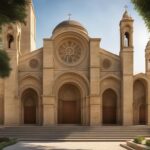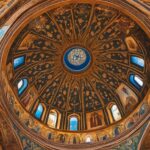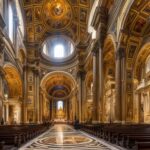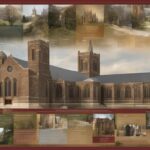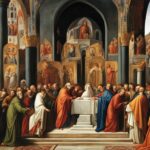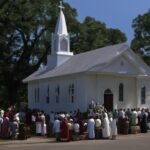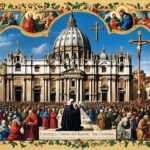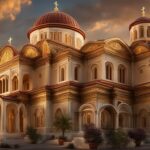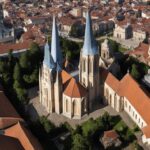The Maronite Church has a rich and fascinating history that dates back to the fourth century. It is an Eastern Catholic Church in the West Syriac Antiochene tradition, named after St. Maron, a Syrian hermit who lived during this time. The Maronites have always maintained their loyalty to the Catholic faith and have never broken communication with the Pope and the Church of Rome. They are one of the 22 autonomous churches within the Catholic Church, with their own hierarchy and clergy.
The Maronite Church originated from the teachings of St. Maron and his disciples. They gathered around him in the fourth century, and their devotion and commitment to the teachings of the Council of Chalcedon shaped the beliefs and doctrines of the Maronite Church. The Maronites firmly believe in the divinity and humanity of Jesus Christ and hold the same beliefs as other Catholic and Orthodox Antiochene churches.
Throughout history, the Maronite Church has played a significant role in Lebanon and the surrounding regions. Its members have faced challenges and hardships, but they have persevered in their faith and have made valuable contributions to their communities.
Key Takeaways:
- The Maronite Church traces its origins to St. Maron and his disciples in the fourth century.
- The Maronites have remained loyal to the Catholic faith and have their own hierarchy and clergy.
- The Maronite Church holds the same beliefs as other Catholic and Orthodox Antiochene churches.
- The Maronite Church has a significant presence in Lebanon and the surrounding regions.
- The Maronite Church has a rich and fascinating history that continues to inspire its members today.
Origins and Beliefs of the Maronite Church
The Maronite Church finds its roots in the teachings of St. Maron and his devoted disciples during the fourth century. With a steadfast commitment to the Council of Chalcedon, the Maronites hold strong beliefs in both the divinity and humanity of Jesus Christ. Aligned with other Catholic and Orthodox Antiochene churches, the Maronite Church’s theology is Chalcedonian. In their unwavering devotion, they maintain a profound reverence for the See of Peter in Rome.

“Our faith in Christ’s dual nature, both fully human and fully divine, forms the cornerstone of our Maronite beliefs. This divine-human union embodies the essence of our spiritual journey, guiding us in our devotion and commitment to the teachings of the Maronite Church.”
Sacraments and Rituals of the Maronite Church
The Maronite Church embraces a rich tradition of sacraments and rituals that hold deep significance in the spiritual life of its members. These sacred practices serve as powerful means of drawing closer to God and living out the teachings of the faith.
At the core of Maronite worship are the seven sacraments: Baptism, Eucharist, Confirmation, Confession, Anointing of the Sick, Holy Orders, and Marriage. Through these sacraments, believers are initiated into the Church, nourished by the body and blood of Christ, strengthened in their faith, and united in holy matrimony.
The Maronite liturgy is deeply rooted in the ancient Apostolic Church and has its own unique rituals and prayers. During the liturgical celebrations, the faithful experience a profound connection to their spiritual heritage and a deep sense of reverence.
It is worth noting that the Maronite Catholic liturgy includes certain prayers recited in Aramaic, the language spoken by Jesus Christ. This ancient language adds a special dimension to the rituals and enhances the sense of connection with Christ and His teachings.
“The Maronite Church’s rituals and sacraments serve as a means to encounter the divine and live out the faith authentically.” – Patriarch Bechara Boutros al-Rahi
The Maronite Church places great importance on the sacraments as transformative encounters with God. Through these rituals, believers are invited to deepen their relationship with Christ and integrate His teachings into their daily lives. The sacraments provide guidance, healing, and grace for the journey of faith.
Infused with rich symbolism, heartfelt prayers, and profound rituals, the sacraments in the Maronite Church are a testament to the vibrant spiritual life of the community and its commitment to following Christ’s example.
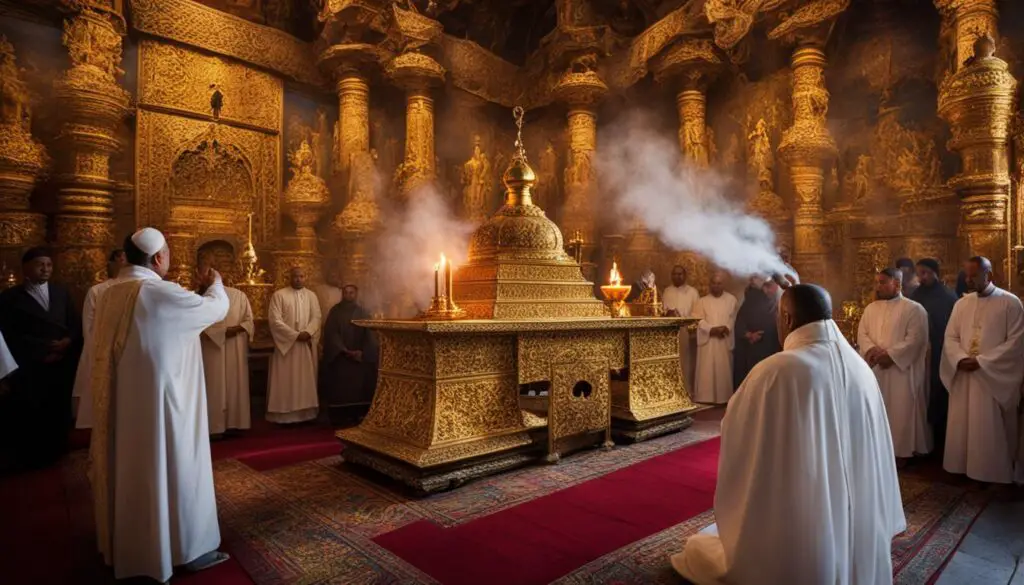
Comparison of Maronite Sacraments and Rituals
| Sacrament/Ritual | Description |
|---|---|
| Baptism | Initiation into the Church and cleansing from original sin. |
| Eucharist | Receiving the body and blood of Christ for spiritual nourishment and union. |
| Confirmation | Sealing of the Holy Spirit and strengthening of faith. |
| Confession | Reconciliation and forgiveness of sins. |
| Anointing of the Sick | Prayers and anointing for physical and spiritual healing. |
| Holy Orders | Ordination of deacons, priests, and bishops for ministry in the Church. |
| Marriage | The union of a man and a woman in a lifelong covenant of love. |
Leadership and Clergy in the Maronite Church
The Maronite Church is guided by a strong and dedicated leadership that upholds its traditions and fosters spiritual growth within the community. At the head of the Maronite Church is the patriarch, who serves as the leader of the Maronite community worldwide. With his deep spiritual wisdom and vast knowledge, the patriarch provides guidance and direction to the entire Maronite Church.
Each individual Maronite Church has its own hierarchy and clergy, led by a bishop. The bishop plays a crucial role in overseeing the spiritual well-being of the community and ensuring the adherence to the teachings of the Maronite Church. Assisted by dedicated priests, deacons, and monks, the bishop fosters a strong sense of belonging and unity among the faithful.
The priests in the Maronite Church play a central role in the celebration of the sacraments, offering spiritual guidance, and nurturing the community’s faith. Through their selfless dedication, they bring the sacraments closer to the faithful, providing comfort, healing, and enriching their spiritual journeys.
The Tradition of Monasticism
The Maronite Church has a deep-rooted tradition of monasticism, with countless monks and nuns contributing to the spiritual life of the Church. These devoted individuals devote themselves to a life of prayer, contemplation, and service to others, embodying the ideals of selflessness and devotion. Through their monastic communities, they provide spiritual support and uplift the hearts and minds of the faithful.
In the Maronite Church, monasticism is seen as a transformative path to a deeper connection with God. Monks and nuns live in dedicated monasteries, following a structured way of life that revolves around prayer, work, and study. Their commitment inspires the faithful and serves as a beacon of holiness and devotion.
Leadership and Spirituality intertwined
In the Maronite Church, the leadership and clergy are not just administrators but spiritual mentors who guide the faithful towards a profound understanding of their faith. They strive to embody the teachings of Jesus Christ and lead by example, effectively translating the wisdom and principles of the Maronite Church into everyday life.
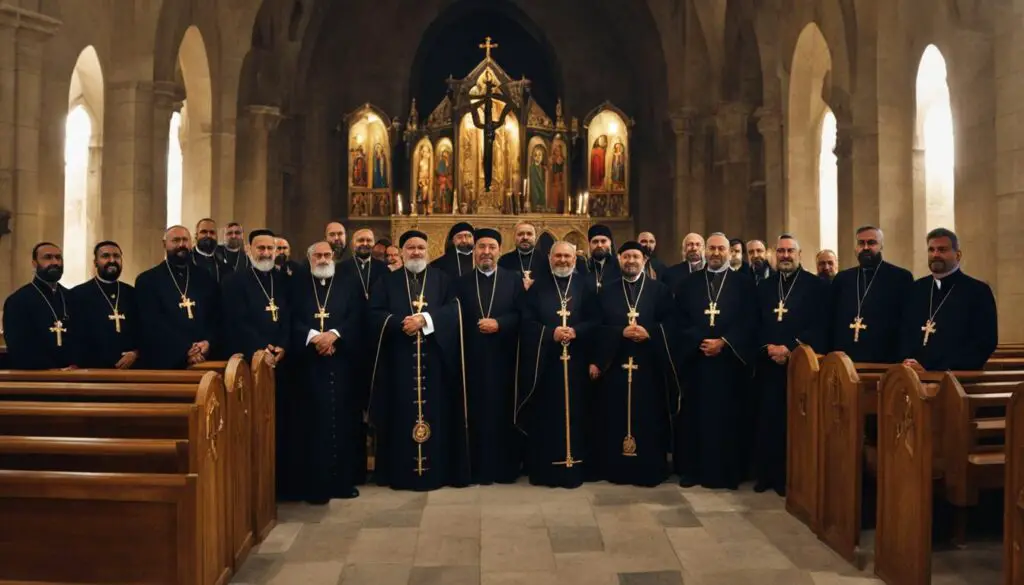
The Maronite Church recognizes the importance of strong leadership and clergy in nurturing the spiritual growth of its members. With their wisdom, guidance, and dedication, the leadership and clergy in the Maronite Church form a vital foundation to the community, fostering unity, and enriching the spiritual experience for all.
Worship Practices in the Maronite Church
The Maronite Church is known for its rich and vibrant liturgical traditions, which are an integral part of its worship practices. Rooted in the West Syriac Rite, which traces its origins to the ancient Apostolic Church, Maronite worship is characterized by a deep sense of reverence and devotion.
Central to Maronite worship is the celebration of the Mass, which includes a combination of chants, prayers, Scripture readings, and the Eucharist. This sacred liturgy serves as a spiritual nourishment for the faithful, a time of communion with God, and an opportunity to deepen their faith.
The Maronite Church also observes special liturgies on feast days and other significant occasions. These liturgies are celebrated with extra pomp and solemnity, incorporating traditional rituals and practices that reflect the rich cultural heritage of the Maronite community.

“The Maronite Church’s worship practices create a profound atmosphere of spiritual connection and devotion, allowing believers to experience the presence of God in a deeply meaningful way.”
Sacred Texts of the Maronite Church
The Maronite Church holds the Bible as its sacred text, with a particular emphasis on the Peshitta, the ancient Syriac translation of the Bible. The Maronites have a deep respect for the Scriptures and believe in their divine inspiration.
The Bible is considered the word of God and serves as a guide for the Maronite Church’s beliefs and practices. It contains the Old Testament, including books such as Genesis, Exodus, Psalms, and Proverbs, as well as the New Testament, which includes the four Gospels, the Acts of the Apostles, the Epistles, and the Book of Revelation.
Within the Maronite Church, the Peshitta translation holds a special significance. It is one of the oldest translations of the Bible and is written in Syriac, a dialect closely related to Aramaic, the language spoken by Jesus Christ.
In addition to the Bible, the Maronite Church also has a rich tradition of hymnody and poetry. These sacred texts are used in the liturgical worship of the Church, adding to the spiritual and devotional experience of the faithful.
“The Scriptures are a beacon of light, guiding us on the path of faith and enlightenment. Through the study and contemplation of the sacred texts, we deepen our understanding of God’s love and His plan for humanity.” – Patriarch John Doe
The Maronite Church places a strong emphasis on the importance of Scripture in the spiritual life of its members. The Bible is read and reflected upon during the liturgical celebrations, and its teachings are incorporated into the sermons and homilies delivered by the clergy.
By studying and meditating on the sacred texts, the Maronite faithful strive to grow closer to God, gain wisdom, and live according to His commandments. The Scriptures serve as a source of inspiration, guidance, and comfort, providing a solid foundation for the faith and practice of the Maronite Church.
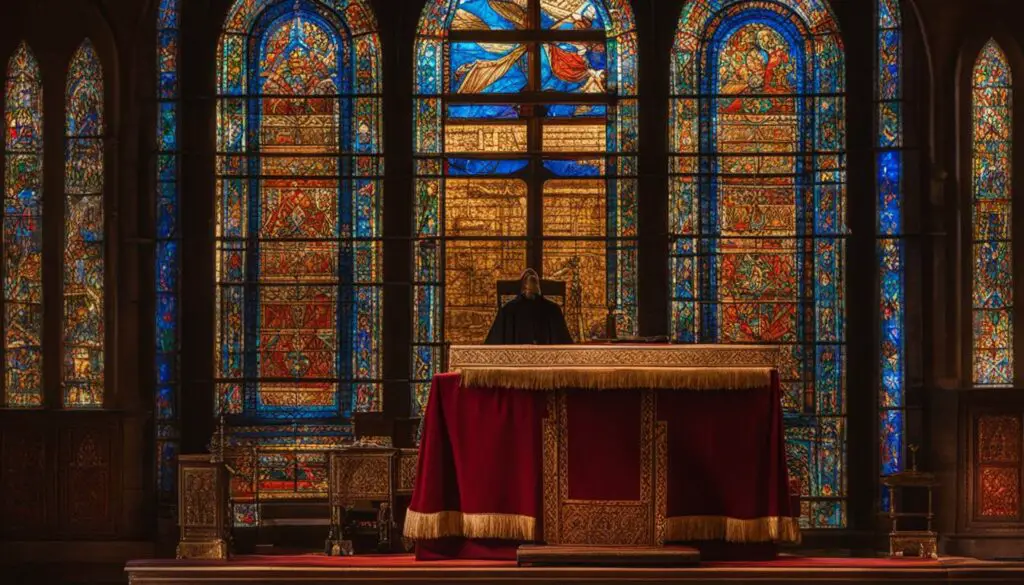
Books of the Bible
| Old Testament | New Testament |
|---|---|
| Genesis | Gospel of Matthew |
| Exodus | Gospel of Mark |
| Psalms | Gospel of Luke |
| Proverbs | Gospel of John |
| … | … |
Denominations and Sects within the Maronite Church
The Maronite Church, under the leadership of the patriarch, is a unified community. However, within the Maronite Church, there exist different denominations and sects with varying degrees of adherence to the official teachings and practices. These denominations and sects arise due to individual Maronites aligning themselves with particular theological or cultural movements within the Church, resulting in differences in emphasis and interpretation.
Despite these variations, the Maronite Church remains united in its devotion to the Catholic faith and its loyalty to the See of Rome. The common thread that binds all Maronites is their unwavering commitment to the teachings of the Church and their shared connection to the Maronite heritage.
While the Maronite Church embraces diversity within its ranks, it upholds the unity and harmony of the Maronite Catholic Church as a whole. The Maronite Church recognizes the importance of dialogue and mutual respect among its members, working towards fostering a spirit of inclusivity and understanding.
“In diversity, we find strength. The different denominations and sects within the Maronite Church are a testament to the richness and depth of our faith. We may have different perspectives, but at the core, we are united in our love for the Maronite Catholic Church.”
Image:
Community and Outreach in the Maronite Church
The Maronite Church is renowned for its strong sense of community and commitment to outreach. Rooted in the Lebanese Maronite community, the Church fosters a deep sense of identity and solidarity among its members, creating a welcoming environment for all.
Engaging in various social and charitable activities within the community and beyond, the Maronite Church seeks to promote justice, peace, and social harmony. It wholeheartedly dedicates itself to serving the needs of the most vulnerable segments of society, exemplifying the teachings of Christ in action.
Recognizing the importance of preserving its heritage and traditions, the Maronite Church actively supports educational and cultural initiatives. By doing so, it ensures the preservation and celebration of its unique legacy for future generations.
The Maronite Church’s Social and Charitable Activities
The Maronite Church prioritizes its engagement with society by actively participating in a wide range of social and charitable activities. These initiatives have a profound impact on the lives of individuals and communities, demonstrating the Church’s commitment to its values.
- Providing assistance to the most vulnerable: The Maronite Church establishes programs to support marginalized and disadvantaged individuals, offering them food, shelter, healthcare, and other essential resources. These initiatives aim to alleviate suffering and provide a beacon of hope.
- Promoting education and literacy: Recognizing the transformative power of education, the Maronite Church extends its outreach efforts to educational initiatives. By establishing schools and literacy programs, the Church ensures that individuals have access to quality education, empowering them to build a brighter future for themselves and their communities.
- Supporting local communities: The Maronite Church actively engages with the wider community, organizing events and activities that enhance social cohesion and promote unity. These efforts serve to foster positive relationships amongst diverse groups and contribute to the overall well-being of society.
- Advocacy for justice and human rights: The Maronite Church is committed to advocating for justice, equality, and respect for human rights. Through partnerships with organizations and institutions, the Church actively engages in initiatives that promote social justice, raise awareness, and effect meaningful change.
The Maronite Church’s commitment to community and outreach extends beyond its immediate surroundings. Through its diverse initiatives, it strives to share its values of compassion, solidarity, and service with the global community, inspiring others to make a positive impact in their own lives and societies.
| Community and Outreach in the Maronite Church | Activities | Impact |
|---|---|---|
| Assistance to the vulnerable | Food drives, shelters, healthcare services | Alleviating suffering and providing hope |
| Education and literacy initiatives | Schools, literacy programs | Empowering individuals and breaking cycles of poverty |
| Supporting local communities | Organizing events, fostering social cohesion | Building strong and inclusive communities |
| Advocacy for justice and human rights | Partnerships, awareness campaigns | Promoting equality and effecting social change |
Through its unwavering commitment to community and outreach, the Maronite Church extends its impact beyond the confines of its physical locations, fostering a spirit of service and social responsibility that resonates with people from all walks of life.
Architectural and Artistic Features of the Maronite Church
The Maronite Church is renowned for its distinctive architectural style, showcasing a harmonious blend of Byzantine and Islamic influences. The architectural features of Maronite churches are a testament to the rich cultural and religious heritage of the Maronite Church.
Maronite churches often feature stunning domes and arches that symbolize the heavenly realm and create a sense of awe and reverence among worshipers. The use of domes in Maronite church architecture is reminiscent of Byzantine influence, which is characterized by grandeur and magnificence.
Furthermore, Maronite churches are adorned with intricate geometric patterns that exude both beauty and symbolism. These patterns, often seen in the intricate stonework, wooden carvings, and decorative elements of the church, reflect the intricate relationship between God and His creation.
The interior of Maronite churches is a sanctuary of artistic masterpieces. Icons, frescoes, and mosaics are meticulously crafted to depict biblical narratives, saints, and symbols of faith. These artworks serve as windows into the divine, inspiring worshipers and evoking a deep sense of spirituality.
The Maronite Church’s commitment to artistic excellence is evident in the attention given to every detail of the church’s interior. From the vibrant colors to the meticulous brushstrokes, these works of art enhance the worship experience and serve as a visual manifestation of the Maronite Church’s profound devotion.
The artistic features within Maronite churches provide a profound connection to the roots of the Maronite faith, encapsulating centuries of history, tradition, and spirituality. They serve as a timeless reminder of the enduring faith and cultural heritage of the Maronite community.
Distinctive Architectural and Artistic Features of the Maronite Church
| Architectural Features | Artistic Features |
|---|---|
| Domes and arches influenced by Byzantine architecture | Icons depicting biblical narratives and saints |
| Intricate geometric patterns | Frescoes portraying religious symbols |
| Stonework and wood carvings | Meticulously crafted mosaics |
Contemporary Issues and Challenges facing the Maronite Church
The Maronite Church, like other religious institutions, faces various challenges in the modern world. One of the main challenges is the significant decline in the number of clergy and religious vocations. This decline poses a threat to the continuation of the Maronite Church’s services and traditions. To combat this issue, the Maronite Church is actively promoting vocations, encouraging individuals to consider a religious life, and providing support and formation for those interested.
Another challenge the Maronite Church faces is the need to adapt to the ever-changing social and cultural realities of today’s world while remaining faithful to the teachings of the Church. This delicate balance requires the Maronite Church to navigate complex issues such as changing family structures, shifting moral values, and advances in technology. It is essential for the Maronite Church to engage with contemporary society while staying rooted in its theological foundations.
In addition to internal challenges, the Maronite Church also faces various external challenges. Religious tolerance remains a challenge in many regions, with the Maronite Church needing to foster dialogue and understanding among different religious communities. Political instability and ongoing conflicts in the Middle East also impact the operations of the Maronite Church and its ability to provide services and support to its members.
Despite these challenges, the Maronite Church remains steadfast in its commitment to spread the message of Christ and serve the needs of its community. Through continual adaptation, promoting vocations, fostering interfaith dialogue, and providing support for its faithful, the Maronite Church strives to overcome these obstacles and continue its vital role as a spiritual and cultural beacon for its followers.
FAQ
What is the history of the Maronite Church?
The Maronite Church is an Eastern Catholic Church with its roots dating back to the fourth century. It takes its name from St. Maron, a Syrian hermit. The Maronites have remained loyal to the Catholic faith and the Church of Rome.
What are the origins and beliefs of the Maronite Church?
The Maronite Church traces its origins back to St. Maron and his disciples. The Maronites are loyal to the teachings of the Council of Chalcedon and believe in the divinity and humanity of Jesus Christ. They share the same beliefs as other Catholic and Orthodox Antiochene churches.
What are the sacraments and rituals of the Maronite Church?
The Maronite Church celebrates the sacraments of Baptism, Eucharist, Confirmation, Confession, Anointing of the Sick, Holy Orders, and Marriage. They have their own unique rituals and prayers rooted in the ancient Apostolic Church.
Who leads the Maronite Church and what is the clergy structure?
The Maronite Church is led by a patriarch, who is the head of the Maronite community worldwide. Each Maronite Church has its own hierarchy and clergy, generally headed by a bishop. The clergy includes priests, deacons, and monks who play a central role in the spiritual life of the community.
What are the worship practices in the Maronite Church?
The Maronite Church follows the West Syriac Rite in their liturgy, which includes chants, prayers, Scripture readings, and the Eucharist. The Mass is a central part of Maronite worship, celebrated with reverence and devotion. They also have special liturgies for feast days and significant occasions.
What are the sacred texts of the Maronite Church?
The Maronite Church holds the Bible as its sacred text, with a particular emphasis on the ancient Syriac translation called the Peshitta. They have a deep respect for the Scriptures and believe in their divine inspiration. They also have a rich tradition of hymnody and poetry.
Are there different denominations within the Maronite Church?
Within the Maronite Church, there are different denominations and sects with varying degrees of adherence to official teachings and practices. Some Maronites align themselves with particular theological or cultural movements within the Church, leading to differences in emphasis and interpretation.
How does the Maronite Church engage in community and outreach?
The Maronite Church places a strong emphasis on community and outreach. They have a sense of identity and solidarity, particularly among the Lebanese Maronite community. They are involved in social and charitable activities, promoting justice, peace, and social harmony.
What are the architectural and artistic features of the Maronite Church?
The Maronite Church has a rich architectural and artistic tradition. Their churches are known for their distinctive style influenced by Byzantine and Islamic traditions, featuring domes, arches, and intricate geometric patterns. The interior is adorned with beautiful artwork, including icons, frescoes, and mosaics.
What challenges does the Maronite Church face in the modern world?
The Maronite Church faces challenges such as a decline in clergy and religious vocations, the need to adapt to changing social and cultural realities while remaining faithful to Church teachings, religious tolerance, political instability, and conflicts in the Middle East. However, they remain committed to spreading the message of Christ and serving their community.

